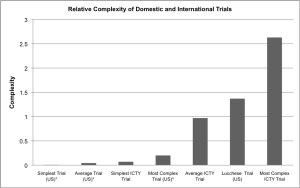[Stuart Ford is an Assistant Professor at The John Marshall Law School.]
It is common to see people
criticize international tribunals as too slow, too expensive, and inefficient. Professor Whiting even
argues this is now the consensus position among “policymakers, practitioners, and commentators (both academic and popular).” But are these criticisms accurate? At least with respect to the International Criminal Tribunal for the former Yugoslavia (ICTY), I believe the answer is no.
Most of those who have criticized the ICTY are implicitly comparing the ICTY to trials in domestic courts. And indeed, ICTY trials take much longer than the average domestic criminal proceeding. For example, in 2011 nearly 70% of criminal trials in federal courts in the United States took one day or less to try and there were only 37 trials that lasted more than 20 days. See
here at Table T-2. In comparison, the average ICTY trial has lasted 176 days. So, it is true that trials in the U.S. are much quicker than trials at the ICTY, but it is also true that ICTY trials are vastly more complex than the average domestic trial, and we generally expect more complex trials to be more expensive. As a result, it is misleading to compare the cost and length of the ICTY’s trials to those in other courts without first accounting for the complexity of those trials.
Consequently, I
propose a method for measuring trial complexity based on the number of trial days, trial exhibits and trial witnesses needed to complete a trial. The figure below shows the relative complexity of trials at the ICTY and in the U.S. As you can see, the
average domestic trial barely registers on the chart, and even the Lucchese trial, one of the
most complex trials ever conducted in the U.S., is only about half as complex as the ICTY’s most complex trial. But measuring complexity is just the first step to understanding whether the ICTY is too slow and expensive.



